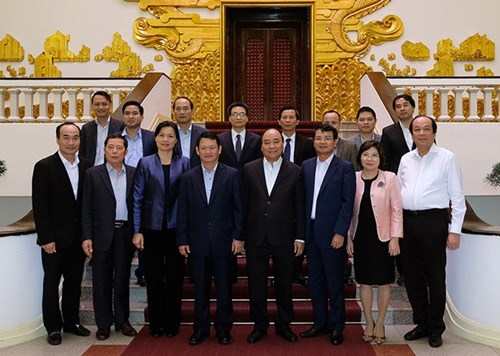At a working session with key leaders of the northern border province of Lao Cai in Hanoi on December 6, the PM agreed in principle to transform Sa Pa district in the province into a town, aiming to seek an international status for Sa Pa, which has been recently recognized as a national tourism site.
Apart from protecting traditional culture, it is a must to improve living standards of local people, the leader said.
He urged relevant ministries and agencies to coordinate with Lao Cai to roll out typical criteria for Sa Pa, explaining that the development of a mountainous town differs from that in the delta area.
    |
 |
| Prime Minister Nguyen Xuan Phuc (4th, right) and officials at the working session |
Therefore, an assessment council should be established to submit the plan to the Government before it is sent to the National Assembly’s Standing Committee, the PM said.
Regarding Lao Cai’s socio-economic development, the leader asked the province to pay attention to border economy, tourism and organic agriculture, and complete local infrastructure to promote the economic corridor which links Lao Cai, Hanoi, Hai Phong and Quang Ninh of Vietnam with China’s Yunnan province.
He also agreed with the province’s proposals to turn Lao Cai into a leading locality in the North-western region, in terms of not only poverty reduction but also budget balance.
In 2017, Lao Cai recorded an economic growth rate of about 11 percent, with gross regional domestic product (GRDP) per capita reaching 51.2 million VND (2.247 USD), up 11.3 percent over the previous year, ranking second among northern midland and mountainous provinces, after Thai Nguyen.
Covering more than 68,000ha, Sa Pa has a population of 65,000, belonging to six ethnic groups, of which ethnic minorities make up 87 percent of the total population.
Located 350km northwest of Hanoi capital city, Sa Pa is 1,600m high above sea level, with the average temperature of 15-18°C. The whole town is dominated by the Hoang Lien Son mountain range which is famous with the Indochina’s highest mountain of Fansipan at a height of 3,142m above sea level.
Discovered in 1903 by the French, Sa Pa has many natural scenic sites such as Ham Rong Mountain, Thac Bac (Silver Waterfall), Cau May (Rattan Bridge), Bamboo Forest and Ta Phin Cave.
Last year, Sa Pa welcomed 1 million tourists, up 35 percent year-on-year, earning more than 2.5 trillion VND (110 USD) from the tourism sector. The number of holiday-makers to Sa Pa is expected to reach 2.5 million in 2017, about 4 million in 2020 and over 8 million in 2030.
Source: VNA